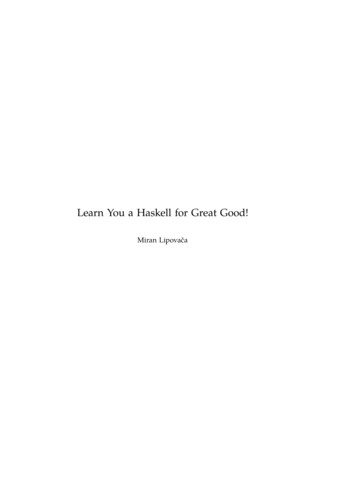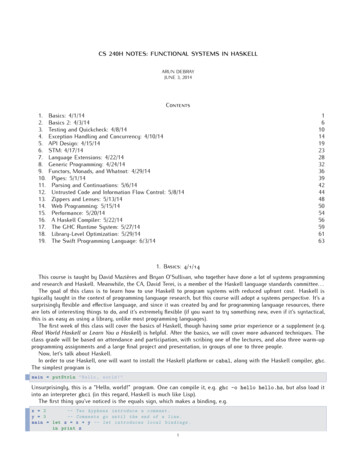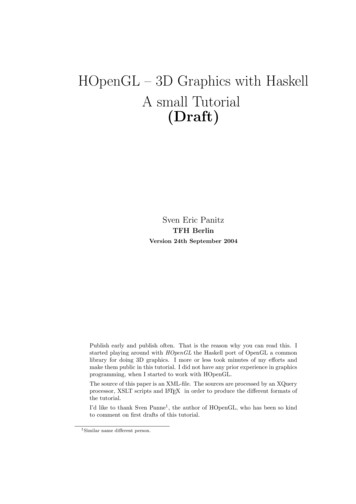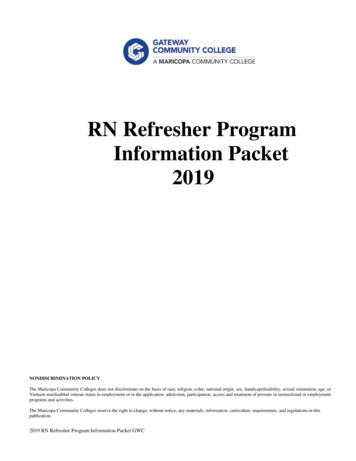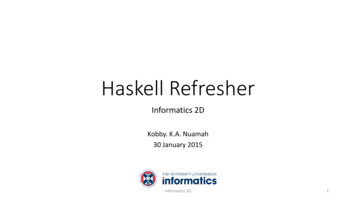
Transcription
Haskell RefresherInformatics 2DKobby. K.A. Nuamah30 January 2015Informatics 2D1
Haskell Purely functional! : “Everything is a function” Main topics: RecursionCurryingHigher-order functionsList processing functions such as map, filter, foldl, sortBy, etcThe Maybe monad More on Haskell: ics 2D2
Types Unlike other programming languages like Java, Haskell has typeinference. However, type declarations ensures that you are specific about theinput arguments of your function and the output values. Example:next :: Trace - [Trace] The next function takes an argument of type Trace and returns a listof TracesInformatics 2D3
Type Synonymstype Trace [(Int,Int)]type Game [Int] The type Trace is a synonym for a list of (Int,Int) tuples. For code clarity.Informatics 2D4
Recursion Important role in Haskell. Function is recursive when one part of its definition includes thefunction itself again. Always have a termination condition to avoid infinite loop.length :: [a] - Intlength [] 0length (x:xs) 1 length xsInformatics 2D5
Currying The process of creating intermediate functions when feeding argumentsinto a complex function. Note: all functions in Haskell really only take one argument Example:2 * 3 in Haskell: (*) function takes first argument 2, and return an intermediatefunction (2*) The new function (2*) takes one argument,3, and completes themultiplication Applying only one parameter to a function that takes two parametersreturns a function that takes one parameterInformatics 2D6
Higher-Order Functions Functions are just like any other value in Haskell. Functions can take functions as parameters and also return functions.map :: (a - b) - [a] - [b]map [] []map f ( x: xs ) f x : map f xs Map takes a function and list and applies that function to everyelement in the list.Informatics 2D7
List Processing Functions(map, filter, foldl, etc.) map : takes a function and list and applies that function to everyelement in the list.map :: (a - b) - [a] - [b] filter: takes a predicate (function that returns true or false) andlist and then returns the list of all elements that satisfy the predicate.filter:: (a - Bool) - [a] - [a] foldl: takes a binary function, an accumulator and a list. It ‘folds’ upthe items in the list and return a single value.foldl:: (a - b - a) - a - [b] - aInformatics 2D8
List Comprehension Build more specific sets out of general sets. Example: to create a list of integers that are multiples of 2 and greaterthan than 20:[x*2 x - [1.25] , x*2 20]OutputfunctionElementsbound to xInformatics 2DCondition OrPredicate9
Maybe Monad The Maybe monad represents computations which might "go wrong"by not returning a value. If a value is returned, it uses Just a, where a is the type of the value. If no value is available, it returns Nothing. Example:safeDiv::Double- Double- Maybe DoublesafeDiv x y y 0 Nothing otherwise Just (x/y)Informatics 2D10
Coursework Overview Trace type for search problemstype Trace [(Int,Int)]1 Example : A path from (1,1) to ,2)]678910Informatics 2D1110
Successor Function The next function returns the possible continuations of the pathnext::Trace- [Trace]1 Example : Suppose we start from are at (4,2) Possible continuations generated by (5,2)]]234567891234x5678910Informatics 2D1210
Consistency with representation Be consistent with your representation of Traces in ,(2,2),(1,2),(1,1)] Both are ok, provided you are consistent with the head and tail ofyour list. Same applies to [Trace]Informatics 2D13
Higher-Order Functions in CourseworkExample:bestFirstSearch::(Trace - Bool) - (Trace - [Trace]) - ((Int,Int) - Int)- [Trace] - Maybe Trace (Trace Bool) is the type of the goal function (same as uninformed search). (Trace [Trace]) is the type of the next function (same as uninformedsearch). ((Int,Int) Int) is the type of the heuristic function, which defines at least anordering on the nodes in the search agenda. [Trace] is the search agenda (same as uninformed search). Maybe Trace is the value the function returns (same as uninformed search ).Informatics 2D14
Game (Tic-Tac-Toe) Representation Game represented as a list of Integerstype Game [Int] A new game will be represented as [-1,-1,-1,-1,-1,-1,-1,-1,-1] Max player is represented by a 1 in the list. Min player is represented as 0 in the list. An unplayed cell is represented as -1XOXOXOOOX Types for Cell and Playertype Player Inttype Cell (Int,Int)Informatics 2D15
Game Representation Examples New Game:[-1,-1,-1,-1,-1,-1,-1,-1,-1] Min Move:[-1,-1,-1,-1, 0,-1,-1,-1,-1]OX Max Move:[ 1,-1,-1,-1, 0,-1,-1,-1,-1]Informatics 2DO16
Lines in Game The Line type represents any of the lines on the game board: rows,columns and diagonals.type Line [Int] Examples of Lines for the game state given: Row 1:[1,0,1]Row 3:[0,0,1] Column 1: [1,0,0]Diagonal 1: [1,1,1] To get all lines for a game state, use function:getLines::Game- [Line]Informatics 2DXOXOXOOOX17
Other useful functions maxPlayer function checks if the given player is max, and returns a Boolean.maxPlayer::Player- Bool switch function alternates between players.switch::Player- Player terminal function checks if the game argument is in a terminal state.terminal::Game- Bool isMoveValid checks if a move made in a given game state is a valid one for a given player.isMoveValid::Game- Player- Cell- Bool playMove makes a move to a cell and returns the new game state. This functions is called for human playermoves.playMove::Game- Player- Cell- Game moves function returns a list of possible moves/successor states that a player can make given a game state.moves::Game- Player- [Game] checkWin function checks if the game state is a win for the player argument.checkWin::Game- Player- BoolInformatics 2D18
Haskell Purely functional! : Everything is a function Main topics: . Informatics 2D 2. Types Unlike other programming languages like Java, Haskell has type inference. However, type declarations ensures that you are specific about the input arguments of your function and the output values. . type Game [Int] The type Trace is .
